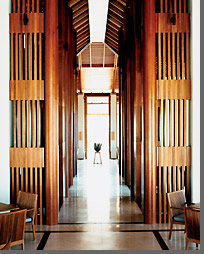|
|||
Fantasy Island |
|||
What's striking about this place, I think to myself while clambering along a jagged bluff, is how un- like the West Indies it seems. Or, rather, how unlike the postcard tropics we have come to expect at island resorts. The setting, for one: In place of clipped lawns, coconut palms, and neon-bright bougainvillea is a chalky, hardscrabble landscape of cacti, palmettos, and scrub. The coastline is largely iron-shore, a rough mix of pitted limestone and lava. Meanwhile, the resort's design—open-sided pavilions made from Indonesian woods, teak-and-rattan armchairs, daybeds upholstered in Jim Thompson silks—recalls Southeast Asia. And not just that: My lunch this afternoon used liberal amounts of shiso, wasabi, and lemongrass. Almost half the staff is Filipino. As for island iconography, well, no one is performing a fire dance, doing the limbo, or playing "Buffalo Soldier" on steel drums. I have not been served a single conch fritter (though the chef did prepare a fabulous conch carpaccio). Nobody has issued me a drink with an umbrella in it. During two days at Amanyara, here in a remote corner of the Turks and Caicos Islands, I've heard no whirring blenders, no whining Jet Skis, no whooping parasailers. Despite intensive searching, I have not seen a trace of pastel. The first few days are a bit of a shock—a pleasant one: Where am I, anyway? Amanyara, which opened last month after eight years in the making, is the first West Indian outpost from Singapore-based Amanresorts, and the largest Aman property yet, with 40 guest pavilions and 33 multi-bedroom villas, the latter of which are being sold as condominiums for $6 million and up. For a company that made its name in Southeast Asia, Amanyara represents a bold move into new terrain. Its arrival in the Turks and Caicos may also be a watershed for this semi-obscure archipelago, thrust again into the limelight after decades of fits and starts. A British crown colony located southeast of the Bahamas, the Turks and Caicos (or TCI) comprise some 40 islands and cays, only eight of them inhabited. The entire population numbers 30,000, although some of those are expats—mainly Americans and Britons—who have bought into the thriving real estate market. Travelers come for superb diving (on the world's third-largest coral reef), sportfishing, and impeccable white-sand beaches. This isn't just hype; the beaches are magnificent. Nearly 300 square miles of TCI are given over to protected parkland and wildlife sanctuaries. Launch a boat from the busy marina on Providenciales (a.k.a. Provo) and within 10 minutes you can land on a sand-fringed cay whose only residents are iguanas. Although Grand Turk is the official capital, Provo has become TCI's commercial hub—solely because of tourism, and only over the past two decades. Few visitors came before 1984, and then Club Med set up shop along Grace Bay Beach, on Provo's northeast coast. Other developers were ready to pounce, but a drug scandal intervened: in 1985, DEA agents in Miami arrested the Turks and Caicos' chief minister for helping Colombian cartels smuggle cocaine into the States via the islands. Many investors were spooked, and the expected boom fizzled. For nearly 10 years Club Med Turkoise had the beach mostly to itself. How idyllic Grace Bay must have seemed back then: a 12-mile stretch of sand with hardly a development in sight. In 1993, Grace Bay Club opened—a 57-room resort that raised the bar in style and service; it would remain Provo's top hotel for years. (The property is now completing a $45 million renovation, with a new spa and redesigned suites.) But the real shift was still to come. Just north of Provo lay a small uninhabited island called Parrot Cay, upon which Kuwaiti investors had begun to erect a hotel—until the Gulf War caused them to abandon it. The property sat dormant for years (the site briefly drew the interest of Amanresorts) before Singaporean hotelier Christina Ong scooped it up; she remade the hotel in the mode of a British colonial plantation with Balinese details, opening it in 1998. Today Parrot Cay bills itself, without apparent irony, as "the world's most exclusive resort," and draws an admittedly fabulous clientele. Strolling across the pool terrace is like attending a performance of Us Weekly Live: there's Christie Brinkley en route to the spa; there's U2's Adam Clayton ordering sashimi; there's Keith Richards with a bunch of weird stuff in his hair. Parrot Cay brought bona fide buzz to the Turks and Caicos, proving that the islands were ready for high-end tourism. A mini-wave of hotel openings and residential development followed. The two trends coincided at the Palms, an opulent coral-stone resort fronting Grace Bay with interiors that recall the theatrical designs of Oliver Messel; all 72 hotel suites were sold as condos before the resort opened in March 2005. By Peter Jon Lindberg CLICK HERE TO READ THE ENTIRE ARTICLE
|
|||
 Travel & Leisure Magazine
Travel & Leisure Magazine